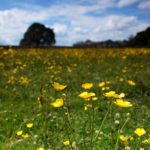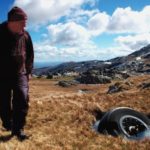de Havilland Vampire XE866
‹ Return to Air Crash Sites

de Havilland Vampire XE866
Flying Officer Phillip Redvers Jones (instructor)
Flying Officer Derek John Brett (pupil pilot)
Both men were killed on 8 August 1957 when their twin seat Vampire T11 crashed at Stanage Edge in the Peak District.
F/O Brett had been undertaking a training session at 40,000 feet, culminating in a high speed descent at 85% the speed of sound. They were in the process of heading back to base at RAF Worksop after a controlled descent through cloud, when the crash occurred.
The Board of Inquiry determined that the cause of the crash was a misreading of the altimeter. Cunningham notes that the device used in T11s was the Mk14 altimeter which was later discontinued because the needle showing tens of thousands of feet was tiny and easily obscured by the other hands, rather like the hands of a watch or clock temporarilly obscuring each other.
Cunningham says that during the high speed descent, F/O Brett may well have misread the tens of thousands of feet, and the Inquiry believed the same, that both crew men thought they were some 10,000 feet higher than they actually were as they descended.
The Vampire struck the flat moor in the photo below, and careered across the surface before finally crashing into the rocks at Crow Chin on Stanage Edge. This area is very popular with hill walkers and rock climbers and as such there are no visible remains, though with effort the enthusiast will find some traces of the crash.
Moscar Moor where the Vampire impacted, viewed from above the terminal impact point at Crow Chin.

Refs;
Pat Cunningham (2006) Peakland Air Crashes – Central Area.
26 comments on “de Havilland Vampire XE866”
Leave a Reply Cancel reply
Image Information
-
Full Size: 2256×1496px
Aperture: f/8
Focal Length: 18mm
ISO: 200
Shutter: 1/320 sec
Camera: NIKON D40



great work once again ian been over there many a time and didnt know about this
brilliant photos
all the best
Great info and fabulous photos as ever Ian, Well done.
Now a small brass plaque marking the site at crow chin,de Havilland Vampire XE866. Small pieces of wreckage have been collected and placed below the plaque .
Thanks Michael. I shall have to get up there and take a photo… Unless you have one? If so, I’d add it to the main narrative above, with a credit to you of course.
some nice light hitting those rocks, looks like a barren place
Great details in the rocks Ian – very nicely taken. Thanks, as always, for the history too – it’s really interesting and poignant.
Cracking report and shots Ian , that vampire is a peach !
I dont recall it being as cold as it looks with that frosting it must have been cold !
Ian… just where do you find the time not just to research but to make the treks? I am jealous, sir! 🙂
What a great mixture of the cold harsh snow and rocks, yet the oncoming sun hints at the warmth to come
Really like the contrast of the hard rock against the landscape. Nice light aswell : )
Lovely escarpment and what a striking looking plane.
Fabulous shots and story as aways Ian. It looks such a lovely spot too. Beautiful rich colour in that top shot! %-)
Stunning landscape and another tragic reminder. Where’s that book then???
Many thanks everyone, always appreciate you reading these stories.
[http://www.flickr.com/photos/cachelog]
I’d love to do a book Bryan, a nice coffee table affair with some big glossy photos, but all the royalties would have to go to charity, I couldn’t bear to make money off the back of these tragedies.
fantastic image, with the graduation in light but also, in colour – from the dark raggedy rocks and snow across to the warmth of the brown grasses [do you call them tussocks?].
very very sad tale, for want of an altimeter that made sense to people. .. as an aside, we were shown images of these during human factors training, and asked to tell the altitude indicated. did yr bl**dy head in, you’d get one wrong and then the next right. hard to fathom why they kept them in use for so long!
[http://www.flickr.com/photos/angwickham]
Tussocks, aye. Sometimes they form in large clumps which are difficult to walk across, real ankle-breakers. In Lancashire these are sometimes called Turks Heads, though whether that is a reference to the Lancashire Fusiliers’ Gallipoli campaign, or dates much further back to the Crusades, I don’t know.
you are a wealth of interestin information! thanks, wasn’t too sure if i was transferring Kiwi terminology incorrectly. duly noted from hereonin. cheers Ian 🙂
Good stuff as usual mate, lovely light in that shot and another sad tale of "pilot error"
At least the altimeter was upgraded – wonder how many crashes it took though?
I’ve spent days climbing there in my youth with no idea I was at a crash site!
poignant to almost travel at the speed of sound and end in silence
Travel at the speed of sound was presumably fairly cutting edge (almost said ground-breaking) back then, or was it common place? But poorly designed instruments is unforgiveble really…… I would think (hope) these days something like that would be weeded out at the development stage. Very sad……
I or my brother used to have a toy one of these, you ran it along the floor and sparks flew out the back !
..and my Dad was in the Lancashire Fusiliers too 🙂
Great beauty in the landscape, quite uplifting with the bright sky and colours, belies the history of the place, only the wisp of snow in the shadows hinting at the sadness. Great work as always
Beautifully Captured.
Wonderful image, and though it may sound weird, if my life had ended here, I’d think it couldn’t have been in a more beautiful place, though the story you tell of it sounds horrific!